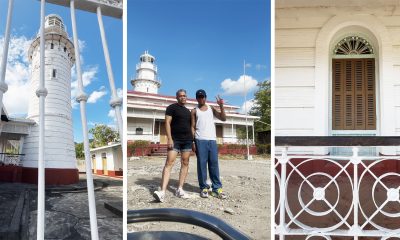Beauty & Fashion
How to treat your embarrassing body problems
Unfortunately, our bodies aren’t always on our site, and there are a lot of things that they do that aren’t necessarily unhealthy, but are embarrassing or uncomfortable. Here are some of those issues, and ways that you can change them.

Unfortunately, our bodies aren’t always on our site, and there are a lot of things that they do that aren’t necessarily unhealthy, but are embarrassing or uncomfortable.
Here are some of those issues, and ways that you can change them.
EXCESS SWEATING
Particularly in the summer, excess sweating can be a difficult thing to deal with for a lot of people, even if in the winter it’s easy to cover up with layers and dark colors. If you’re having problems with excess sweating on any part of your body, talk to your doctor – you may be suffering from hyperhidrosis and they can prescribe treatments such as high strength deodorants or even Botox in your armpits or on the palms of your hands. In the meantime, remember that sweating is natural and nothing to be ashamed of.
HAIR LOSS
Although a lot of men end up losing some hair at some point in their lives, it can still be hard to handle – it’s a blow to the self esteem, particularly if it happens at a young age. A lot of the time there isn’t much that can be done about balding – just remember to treat your hair gently and don’t wash it too harshly. Look online to learn more on how to prevent hair fall problems – there are special shampoos you could use and a lot of hairstyle suggestions. Just remember not to go for a combover – that doesn’t look good on anyone!
STRETCH MARKS
Stretch marks are something that many, many people have – whether they’re on women’s stomachs and breasts after pregnancy, or whether you gained a lot of weight thanks to medication so you have stretch marks on different parts of your body, or whether they simply occurred after puberty. First of all, remember that a lot more people have stretch marks than you may think, so don’t be ashamed. Secondly, remember that even if they’re bright red, they will probably fade to silver after time.
ACNE
Remember that having acne doesn’t mean that you’re dirty or that you don’t eat healthily or take care of your skin – although sometimes cutting certain foods out of your diet can help your acne, you haven’t done anything wrong. Acne is caused by sebaceous glands, which are just below your skin and produce sebum, which can sometimes block your pores.
Make sure that you cleanse and moisturize your skin carefully every morning and evening, that you exfoliate carefully to remove dead skin cells, and that you talk to a skincare specialist if you really want to improve your skin. Birth control or medication can do wonders for many people.
BLADDER WEAKNESS
Urinary incontinence is extremely common – because it isn’t something that usually gets talked about, you may feel embarrassed if your bladder occasionally leaks when you sneeze, exercise, laugh or cough. It’s particularly common in women who have given birth, and who are in the ages between 35 and 60. Stress incontinence can often be caused by a weak pelvic floor, which can be helped by pelvic floor exercises, losing weight and quitting smoking. You can also wear pads for extra safety.
Beauty & Fashion
Renting clothes for sustainable fashion – niche markets work best
The best chance of success is for a rental company to provide clothing within a niche market, such as specific sportswear, and to work closely with the suppliers and clothing manufacturers.

Renting clothes can reduce the fashion industry’s enormous environmental impact, but so far, the business models have not worked very well. The best chance of success is for a rental company to provide clothing within a niche market, such as specific sportswear, and to work closely with the suppliers and clothing manufacturers. This is shown by a study led by researchers at Chalmers University of Technology, Sweden, which highlights the measures that can make clothing rental a success.
The fashion industry is one of the most polluting industries and can account for up to ten percent of global greenhouse gas emissions, worldwide. In Sweden, over 90 percent of the clothes’ climate impact is linked to the purchase of newly produced goods. Therefore, researchers at Chalmers University of Technology, the University of Borås and the research institute Rise have examined alternative, more sustainable business models for the clothing industry.
“Many people have clothes hanging in the closet that are rarely or never used. Renting clothes can extend the use of each garment and thus contribute to more sustainable consumption,” says Frida Lind, Professor at Chalmers and one of the researchers behind the study.
In the study, the researchers analysed nine Swedish companies that have either tried and failed, or are ongoing in the process of creating a sustainable and desirable clothes rental company. From this analysis, the researchers identified three main business models for renting out clothes:
1. Membership model: customers become members and can then borrow clothes for a certain period of time, similar to a library. This model often had an enthusiast as its founder, with a focus on sustainable consumption.
2. Subscription model: customers pay a monthly fee to rent a certain number of garments. These startups worked on scaling up operations and attracting venture capital.
3. Individual rental model: the company would provide specific types of clothing to rent out, often in combination with other equipment, such as outdoor clothing paired with ski equipment.
Difficult to achieve profitability
By interviewing founders, managers and other key people from the nine Swedish companies, the researchers gained an understanding of each company’s situation.
“What struck us was that it seemed so difficult for them to make their business profitable. Several had had to end their investments for various reasons,” she says.
The researchers noted that although there was a willing customer base for renting clothing in this way, they observed several other challenges that made it difficult for companies to achieve profitability.
“Renting out clothes involves many steps where each item of clothing needs to be handled and inspected before it can be rented out again, which takes time. Companies also struggled with high costs for warehousing, logistics and laundry, for example. Especially for the subscription models, there were also difficulties in obtaining venture capital to be able to survive financially through the first phase of building the company. All this shows that these business models need time to establish themselves in the market,” she says.
Specific markets performed best
At the same time, some of the business models worked better than others. Companies that focused on a specific market, such as outdoor clothing, were more successful and sustainable. Especially if they also had a local connection to an outdoor recreational area.
“They seem to have found their niche and seen that there is a specific need that the customer is willing to pay for each time they need to use that type of clothing,” says Frida Lind.
The researchers also examined how the companies created value in collaboration with different stakeholders and concluded that certain collaborations were particularly valuable.
“Rental companies that worked closely with clothing manufacturers and suppliers, such as designers with a sustainability profile, benefited greatly from this as they were able to quickly get feedback on which types of clothing were most popular. They also gained valuable information about the quality of the garments, for example if there was something that often broke,” she says.
Initiatives for change important
In the current study, the researchers have not investigated the environmental and climate impact of the business models specifically, but in general, the environmental effects of our clothes have already been well mapped. For example, previous research from Chalmers has shown that the actual production of garments accounts for 70 percent of the climate impact of Swedes’ clothes throughout their life cycle, and 22 percent of the climate impact is caused by customers’ shopping trips. In the European Union, five million tonnes of clothing are discarded each year – around 12 kilos per person, and in the USA, the average American generates 37 kilos of textile waste each year.
Frida Lind believes that there is a great deal of room for environmental benefits through reduced clothing purchases and extended use of existing garments – especially if it can be done without extra car journeys for consumers.
She emphasises that even if some of the companies and services in the study have not survived, all initiatives that can contribute to the sustainability transition are important. Not least because they help to change attitudes about clothing consumption and increase knowledge about what can and cannot work.
“Our study can be an important contribution to the fashion industry’s sustainability transition, as it shows the possibilities of new business models in this industry. We hope that it can have an impact on decision-makers who need a basis for establishing incentives and financial motivation for a more sustainable fashion industry. Because we see that new and more sustainable business models require time and a long-term perspective to be able to establish themselves,” she says.
Recommendations for the industry
Based on the study’s results, the researchers give a number of recommendations to those who intend to try renting clothes as a business model:
- Focus on niche markets based on target group and product type where the need is clear
- Develop partnerships with suppliers to improve products based on rental experiences.
- Think about logistics and transport in the rental model right from the start to be able to get the model scalable.
More about the research
The scientific article “Exploring renting models for clothing items – resource interaction for value creation” was published in the Journal of Business & Industrial Marketing. The authors are Frida Lind, Chalmers University of Technology, Agnes Andersson Wänström and Daniel Hjelmgren, University of Borås, and Maria Landqvist, Rise. The study has been financed with funds from the Swedish Energy Agency.
Facts and advice about textile consumption
- In the European Union, five million tonnes of clothing are discarded each year – around 12 kilos per person, and in the USA, the average American generates 37 kilos of textile waste each year.
- Over 90 percent of the total climate impact from Swedish clothing consumption is linked to the purchase of newly produced clothes, and 80 percent of our clothes’ climate impact occurs during the production phase.
- It also plays a big role how customers get to the stores. If they walk or cycle instead of driving, they reduce their climate impact by over 10 percent.
- The most important thing that consumers can do is to extend the use of the garments that have already been produced. A t-shirt, for example, is used an average of 30 times. If it is instead used 60 times before it is replaced by a newly produced t-shirt, the climate impact can be halved.
- Extended use can mean that one owner uses the garment for longer, or that several users share ownership. In addition to renting or borrowing clothes, this can be done, for example, by shopping and selling second-hand, arranging clothes swap days or giving away clothes to someone who continues to use them.
- A previous Chalmers study has shown that the actual production of garments accounts for 70 percent of the climate impact of Swedes’ clothes throughout their life cycle. 22 per cent of the climate impact is caused by customers’ shopping trips, 4 per cent by distribution to customers and 3 per cent by washing and drying clothes.
Beauty & Fashion
Sassa opens standalone store in Festival Mall
Compared to traditional department store counters, the standalone store provides more space, better privacy, and a more relaxed shopping experience. Customers can now enjoy a wide selection of styles, with more options to mix and match. The open layout also makes it easier to try on pieces and do personal styling sessions with comfort and convenience.

Located on the Upper Ground Floor of Festival Mall’s West Wing the store features a vibrant, modern space that showcases Sassa’s full lifestyle range—from swimwear and activewear to intimate wear. With bold blue accents, clean lighting, and organized display zones, the store offers a fresh, inviting atmosphere for every Sassa Girl.
Compared to traditional department store counters, the standalone store provides more space, better privacy, and a more relaxed shopping experience. Customers can now enjoy a wide selection of styles, with more options to mix and match. The open layout also makes it easier to try on pieces and do personal styling sessions with comfort and convenience.
For the first time, Sassa brings together all its core collections in one space—designed not just for shopping, but to create a closer, more meaningful connection with the women it was made for.
A Strategic Step Closer to Every Filipina
Recognizing the need to connect more closely with its growing community, Sassa opened its very first standalone store as a way to bring the brand experience directly to its customers—outside the usual department store setup.
“This store is more than just a physical space—it’s a statement of who we are and how far we’ve come,” shares Raiza Limpiada, Marketing & Ecommerce Manager of Sassa. “After more than two decades of being mainly found in department stores, we wanted to create a space that brings us closer to the Filipina—somewhere she can truly feel what Sassa is all about. We’re not just a local brand anymore—we’re becoming a true lifestyle partner.”
After a remarkably strong year of double-digit growth, Sassa is excited about what’s ahead with the opening of its Festival Mall store. The brand is aiming for a 40-50% boost in sales compared to its usual numbers. More importantly, it looks forward to seeing customers spend more time exploring the space, discovering new favorites, and enjoying a more personal shopping experience—all part of Sassa’s journey to grow and connect more deeply with Filipinas in the local fashion scene.
“Our goal is simple,” Raiza adds. “We want to build real relationships, make every visit memorable, and grow alongside our customers. This store is just the beginning.”
Unveiling the Latest Retail Experience
To celebrate this milestone, Sassa hosted a grand opening event attended by brand executives and loyal fans. The festivities included a ribbon-cutting ceremony, store tours, and exclusive first-day offers—creating a memorable experience for early shoppers.
Guests enjoyed limited-time promos, gift-with-purchase deals, and a sneak peek at exclusive styles available only at the Festival Mall store—highlighting the brand’s move toward a more stylish, personalized approach.
With more standalone locations planned, Sassa Festival Mall is just the start. As the brand grows alongside its community, it remains committed to helping every Filipina feel confident and stylish—wherever they go, whatever they do, and in every aspect of their lifestyle.
Experience the Sassa difference for yourself—visit our new Festival Mall store today! Follow @sassa_ph on Instagram and @sassa.ph on Facebook and TikTok for updates.
Beauty & Fashion
Posh Skin Co. launches new pimple patch designs
Posh Skin Co. reinforces its commitment to making acne skin solutions more accessible, fun, and confidence-boosting than ever as it launches new designs of its innovative pimple patches.

Posh Skin Co. levels up its skincare game as it steps into a new era with a clean new look. With this fresh transformation, Posh Skin Co. reinforces its commitment to making acne skin solutions more accessible, fun, and confidence-boosting than ever as it launches new designs of its innovative pimple patches.
Trendy, Effective, and Fun Pimple Patch Designs
Posh Skin Co.’s rebrand also brings in a new lineup of pimple patch designs, crafted to meet different skincare needs while offering a fresh and fashionable take on blemish care. The new designs include yellow star patches, multicolored star patches, metallic foil patches, for a fun, and comfortable acne treatment experience that lasts all day. The ultra-thin daytime patches provide a discreet and seamless coverage for all-day wear, while the nighttime rescue patches are designed to accelerate blemish healing while you sleep.
The pimple patches now come in new packaging with a sleeker, more minimalist look, following Posh Skin Co.’s rebrand.
“We took on a cleaner and simpler packaging approach to let the pimple patch designs speak for themselves,” said renowned fashion stylist and Posh Skin Co. partner, Charmaine Palermo. “We wanted to highlight what truly matters—effective skincare that empowers people.”
Formulated with the same powerful ingredients, these new pimple patch designs offer users improved coverage, comfort, and effectiveness, and make acne care more wearable and confidence-boosting than ever.
A Fresh, New Chapter
Posh Skin Co.’s new look aligns with the brand’s vision of expansion in the Philippines. Not only is Posh Skin Co. adding new designs to its pimple patch offerings but will also be providing new, versatile acne solutions that fit effortlessly into any lifestyle.
“Acne care should be as dynamic as people’s lives because breakouts can happen at any time,” remarked Palermo. “We wanted to offer more options to treat and prevent breakouts effectively, so we are expanding our line with acne solutions that can easily integrate into any skincare routine.”
With inclusivity and accessibility still at the brand’s core, Posh Skin Co. ensures that the skin treatment they offer will still be a stress-free and empowering experience for all users. As it broadens its pimple patch offerings and develops new skin treatment solutions, Posh Skin Co. continues to deliver innovative skincare to Filipinos.
Say “Bye” to Blemishes, and “Hello” to Confidence with Posh Skin Co.® Pimple Patches
Look good and feel confident while treating your blemishes with Posh Skin Co. pimple patches, available for PHP199 on Shopee, Lazada, TikTok Shop, and the official Posh Skin Co. website and select Watsons stores nationwide.
-

 Product Showcase3 weeks ago
Product Showcase3 weeks agoJetstar announces direct flights to Australia from Manila and Cebu
-

 Product Showcase2 weeks ago
Product Showcase2 weeks agoPalawan Group of Companies Introduces ProtekTODO
-

 Destinations4 weeks ago
Destinations4 weeks agoRevisiting the no-entry-allowed Malabrigo Point Lighthouse
-

 Nutrition3 weeks ago
Nutrition3 weeks agoFall for flavor: The new Maple Cloud Cream Collection is here to sweeten, only at Seattle’s Best Coffee
-

 Product Showcase2 weeks ago
Product Showcase2 weeks agoWhy Mega Sardines is a smart, healthy choice for every Filipino family
-

 Pet Care4 weeks ago
Pet Care4 weeks agoWorld-class pet travel safety arrives in PH with Tavo
-

 NewsMakers3 weeks ago
NewsMakers3 weeks agoIs your health care provider really listening to you?
-

 Beauty & Fashion2 weeks ago
Beauty & Fashion2 weeks agoRenting clothes for sustainable fashion – niche markets work best



















